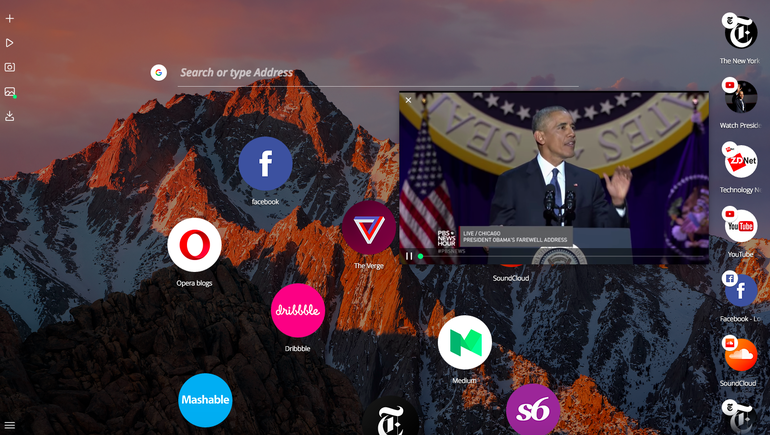
Opera’s new Neon concept browser featuring here a pop-out YouTube video.
Image: Liam Tung/ZDNet
Norwegian software maker Opera has released a completely different take on the desktop browser with Neon, a so-called ‘concept browser’ that eschews tabs for bubble icons and pop-out videos.
Opera is once again taking a crack at shaking up the browser market. After introducing a free VPN and native ad-blocker to its desktop browser last year, its latest effort is Neon, an experimental browser for Mac and Windows desktops.
Neon doesn’t replace the Opera desktop browser but it will be where the company tests new ideas before bringing them to the standard Opera browser.
The aim is to showcase Opera’s long-term vision for the browser in a world where many young people experience smartphones before a desktop, convertibles converge with mobile, and smartphones can stand in for a PC when connected to larger displays.
With this in mind, Krystian Kolondra, head of Opera browser, argues it’s time to rethink the browser for these devices and users to show what the browser could be in five years.
“We believe it’s only a matter of time before you can think about Android PCs,” Kolondra told ZDNet.
“Webpages have moved from text to images, video and they’ve adapted to mobile. But browsers are more or less still the same and the concept of the browser hasn’t changed much in the past 20 years.”
Kolondra said there’s a need in the near future for a really well-designed browser that supports touch.
“Today’s browsers are not so great in this. Also, when looking at expectations from people who started using the internet on mobile, when they come to a PC, it looks so static. If you don’t see any reaction when you touch it, you think it’s broken,” he said.
Some aspects of Neon draw on Opera’s Coast browser for iOS, which offers a grid of icons featuring popular websites beneath a large Google-powered search box.
Neon uses the current desktop’s background image as its main interface, featuring a large Google search box above icons for favorite websites. As with the standard Opera browser, Neon is also built on Google’s Blink engine.
A panel on the left of the interface contains buttons for a video player, download manager, image gallery, and a screenshot tool. Neon also features a split-screen mode, and a pop-out video feature that works fine for YouTube but not Netflix.
The pop-out video was first introduced in a desktop beta last year, which Kolondra says young people loved, but which is a huge “procrastinator” for himself.
One of the most obvious differences between Neon and other desktop browsers is its apparent lack of tabs and shift towards app-like icons. It does actually feature tabs, but they’re displayed as icons in a column on right-hand side of the screen, which expand when clicked on.
“A webpage is really like an application,” Kolondra said. “If you have mobile, you can move the icon, delete the icon, or put it in a folder. We thought. ‘What if a page is more like an object that you can physically move around?’. In Neon, you can drag and drop the page and move it around or have a split screen.”
Also, the idea behind the bubbles is that they are more friendly to touchscreens. The Windows version of Neon supports touch for the growing number of Windows 10 convertibles available today.
While it’s unlikely Neon will replace anyone’s primary browser, it does offer a refreshing take on what the desktop browser could be. And, being a concept browser, it can’t be considered a failure if adoption remains low, while also offering Opera an avenue to test the appeal of various features.
“We need to now start bringing some of the ideas that we have in the concept into regular browsers. We believe the best way to do this, slowly to start showing that the web can be better,” Kolondra said.
“We believe some of these changes are really boosting productivity and we’ll be bringing some of these features in the next weeks and months to our main browser.”
Kolondra said Opera at some point in the future may introduce Neon as a separate mode within the main Opera browser.


